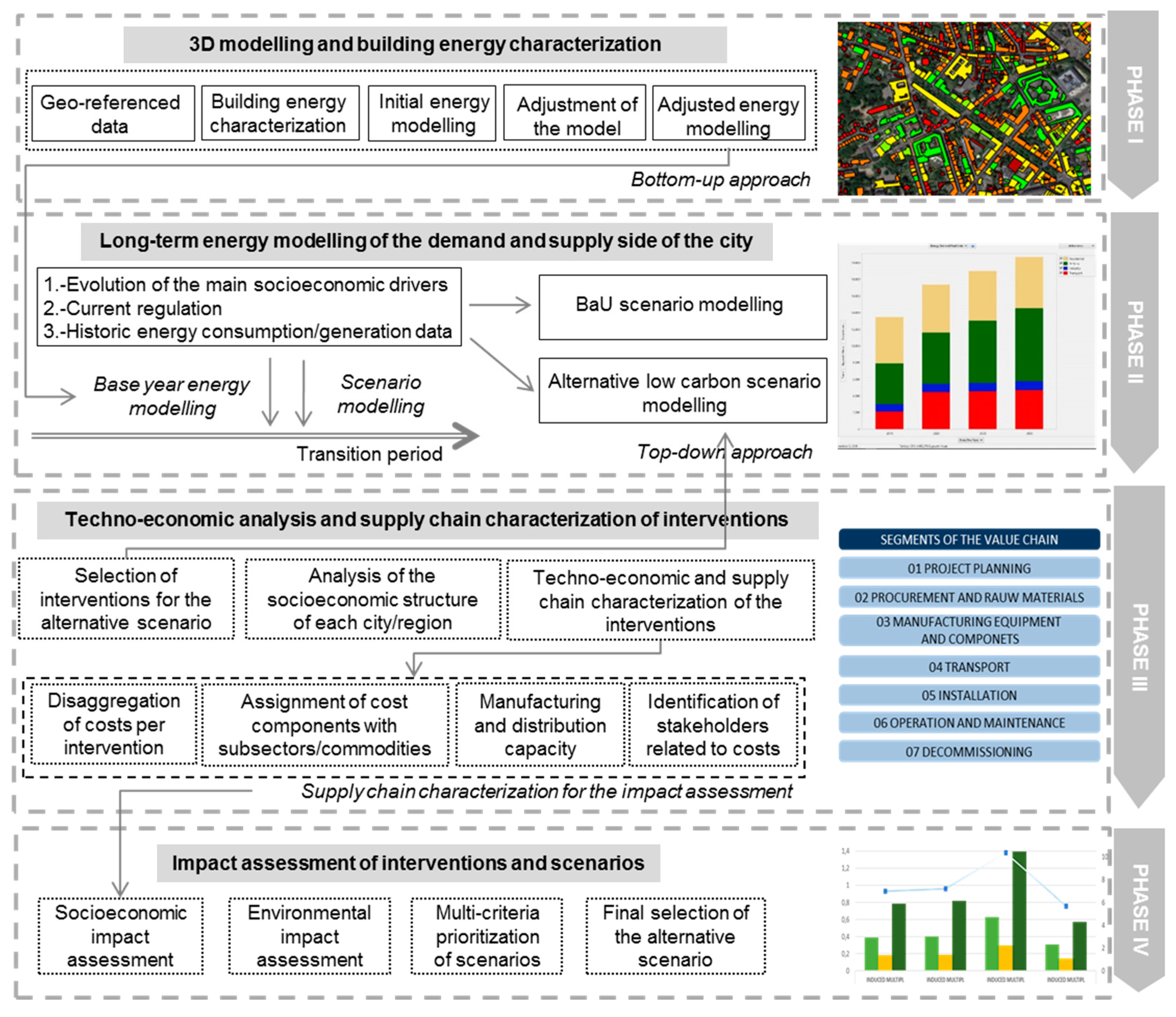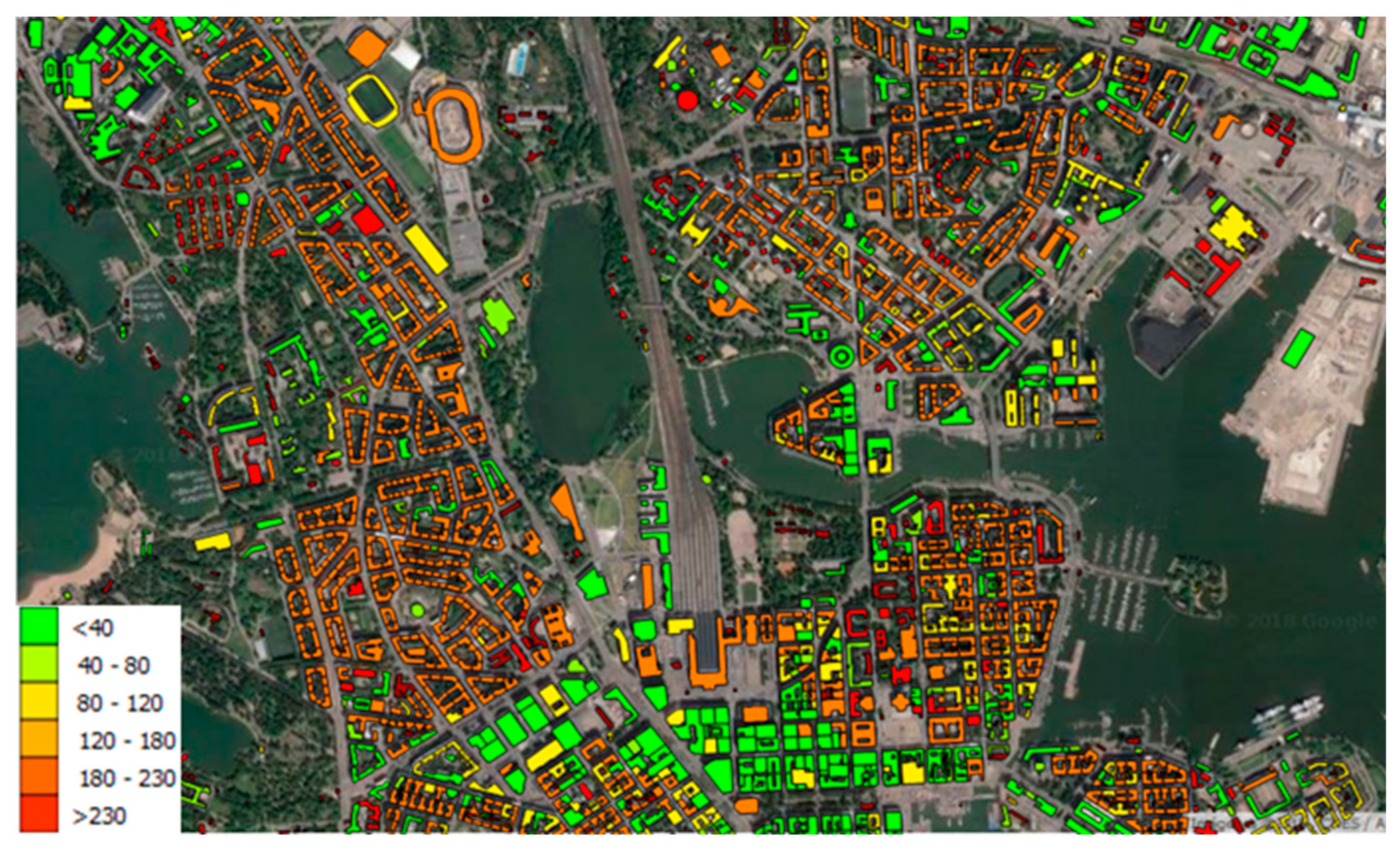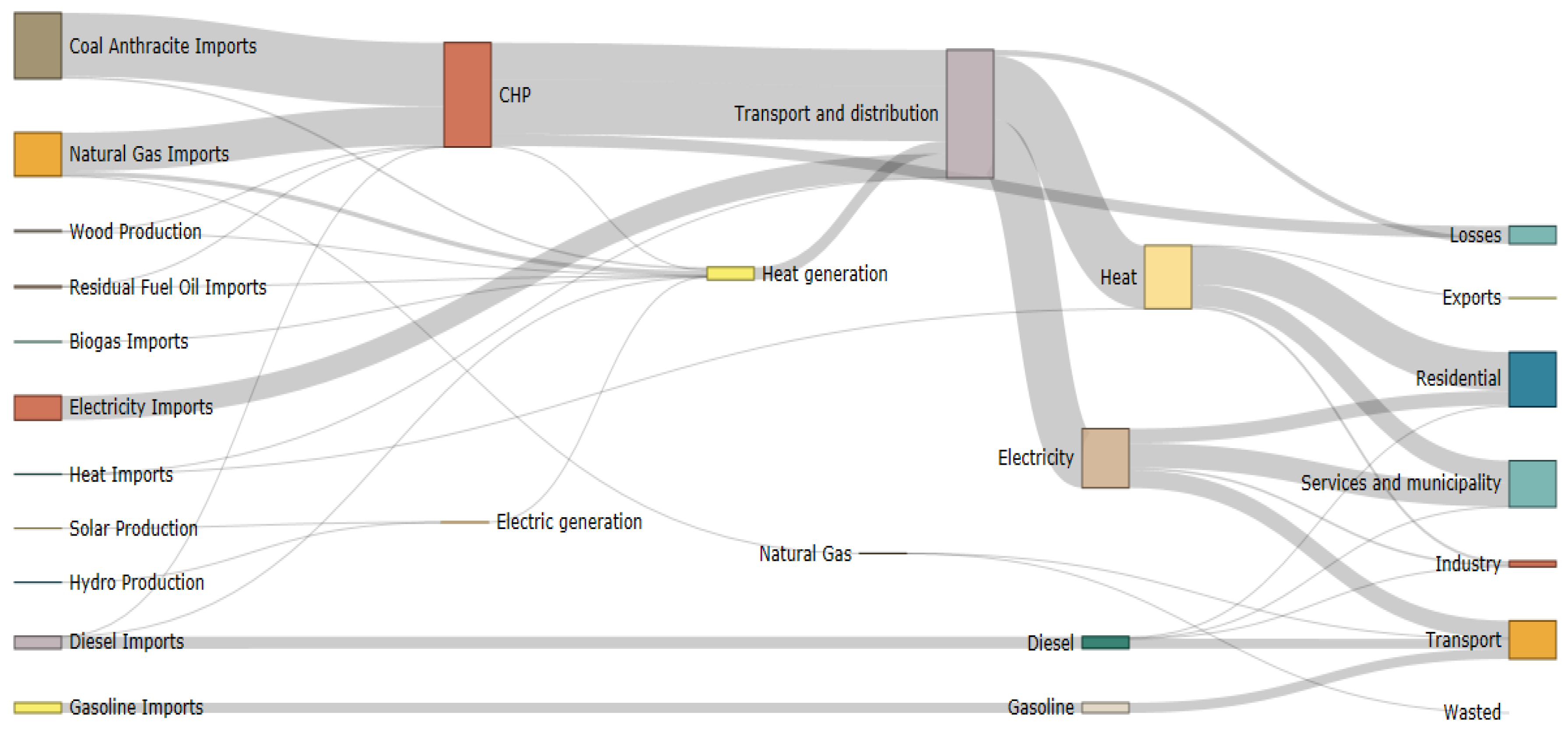Methodology for the Advanced Integrated Urban Energy Planning †
Abstract
:1. Introduction
2. Methodological Approach
2.1. Phase I: 3D Modelling and Buiding Energy Characterzation at City Level
2.2. Phase II: Long-Term Energy Modelling of the Demand and Supply Side of the City
2.3. Phase III: Techno-Economic Analysis and Supply Chain Characterization of Interventions
2.4. Phase IV: Impact Assessment of Interventions and Scenarios
3. Case Study and Results
3.1. Case Study Description and Building Energy Characterization
3.2. Base Year City Energy Balance
3.3. Long-Term Energy Scenario Modelling
4. Conclusions
Supplementary Materials
Funding
Acknowledgments
References
- ENERKAD Tool. Available online: www.enerkad.com (accessed on 24 July 2019).
- Swan, L.G.; Ugursal, V.I. Modeling of end-use energy consumption in the residential sector: A review of modeling techniques. Renew. Sustain. Energy Rev. 2009, 13, 1819–1835. [Google Scholar] [CrossRef]
- CIBSE. Degree-Days: Theory and Application. Available online: https://www.cibse.org/Knowledge/knowledge-items/detail?id=a0q20000008I73TAAS (accessed on 24 July 2019).
- Oregi, X.; Hermoso, N.; Arrizabalaga, E.; Mabe, L.; Muñoz, I. Sensitivity assessment of a district energy assessment characterisation model based on cadastral data. Energy Procedia 2018, 147, 181–188. [Google Scholar] [CrossRef]
- Heaps, C.G. Long-Range Energy Alternatives Planning (LEAP) System, Software Version: 2018.1.18, Stockholm Environment Institute: Somerville, MA, USA, 2016. Available online: https://www.energycommunity.org(accessed on 24 July 2019).
- Arrizabalaga, E. Multi-Criteria Methodology for the Prioritisation of Alternative Energy Transition Scenarios of Cities. Ph.D. Thesis, University of the Basque Country, Bilbao, Spain, 2017. [Google Scholar]
- Arrizabalaga, E.; Hernandez, P.; Portillo-Valdés, L. Long Term Energy Transition Scenario Analysis for the City of Donostia: The 5th annual Sustainable Places International Conference (SP’17). Proceedings 2017, 1, 644. [Google Scholar]
- Jackson, R.W. Cross-Hauling in Input–Output Tables: Comments on CHARM. Working Paper 2014–2002, Regional Research Institute, West Virginia University. Available online: http://rri.wvu.edu (accessed on 24 July 2019).
- Kronenberg, T.H. Erstellung einer Input-Output-Tabelle für Mecklenburg-Vorpommern. Wirtschafts-und Sozialstatistisches Archiv 2010, 4, 223–248. [Google Scholar] [CrossRef]
- Többen, J.; Kronenberg, T.H. Construction of Multi-Regional Input–Output Tables Using the Charm Method Construction of Multi-Regional Input–Output Tables Using the Charm Method. Available online: https://www.tandfonline.com/doi/abs/10.1080/09535314.2015.1091765 (accessed on 24 July 2019).
- Eurostat. Regions and Cities. City Statistics. 2016. Available online: https://ec.europa.eu/eurostat/statistics-explained/index.php/Urban_Europe_%E2%80%94_statistics_on_cities,_towns_and_suburbs (accessed on 24 July 2019).
- Statistics Finland. Statistics Finland. Buldings and Dwellings. 2016. Available online: http://www.stat.fi/til/ras/index_en.html (accessed on 24 July 2019).
- CityGML Buildings. Available online: http://3d.hel.ninja/data/citygml/ (accessed on 24 July 2019).
- The 3D City Information Model Service as Open Data. Available online: http://kartta.hel.fi/3d/ (accessed on 24 July 2019).
- 2D Footprints of Building. Web Feature Service (WFS) Interface. Available online: https://kartta.hel.fi/ws/geoserver/avoindata/wfs (accessed on 24 July 2019).
- Tuominen, P.; Holopainen, R.; Eskola, L.; Jokisalo, J.; Airaksinen, M. Calculation Method and Tool for Assessing Energy Consumptionin the Building Stock. Available online: https://www.sciencedirect.com/science/article/pii/S036013231400033X (accessed on 24 July 2019).
- Hukkalainen, M.; Virtanen, M.; Paiho, S.; Airaksinen, M. Energy planning of low carbon urban areas—Examples from Finland. Sustain. Cities Soc. 2017, 35, 715–728. [Google Scholar] [CrossRef]
- Kemna, R.; Acedo, J.M. Average EU building heat load for HVAC equipment. Final Rep. Framew. Contract ENER C 2014. [Google Scholar]
- DesignBuilder Software Ltd. Design Builder Simulation Tool Version: 3.04.041, DesignBuilder Software Ltd.: Stroud, UK.
- Melo, A.P.; Lamberts, R. Envelope insulation and heat balance in commercial buildings. Build. Simul. 2009, 2243–2250. [Google Scholar]
- Helsinki’s 2030 Climate Technologies, City Performance Tool, March 2016. Available online: http://www.siemens.fi/pool/cc/brochures/sustainability/helsinki-cypt-report---mar-2016.pdf (accessed on 24 July 2019).
- Helsingin kaupunki, Public Works Department. Helsingin Energia, Tommi Valve, Renewing the Public Outdoor Lighting with LEDs—Feasibility Study ofthe “Helsinki LED” Project; Helsinki LED-Hanke Selvitys Ledeihin Siirtymisen Aikataul; Aalto University: Helsinki, Finland, 2015. [Google Scholar]
- Energiateollisuus ry 2017. District Heating in Finland 2016, 2017, Finnish Energy Industries. Available online: https://energia.fi/files/2144/District_heating_in_Finland_2016.pdf (accessed on 24 July 2019).
- Helen. Available online: https://www.helen.fi/aurinko/kodit/aurinkosahko (accessed on 24 July 2019).
- Eurostat. 2018. Available online: http://ec.europa.eu/eurostat/cache/metadata/en/nrg_pc_204_esms.htm (accessed on 24 July 2019).
- European Commision. Urban Data Platform. Data Sharing and Visualization Platform for European Cities and Regions. Available online: http://urban.jrc.ec.europa.eu/download-dataset (accessed on 24 July 2019).




| Building Age | Heating (kWh/m2) | DHW (kWh/m2) | Equipment (kWh/m2) | Lighting (kWh/m2) |
|---|---|---|---|---|
| Residential/Tertiary | Residential/Tertiary | Residential/Tertiary | Residential/Tertiary | |
| Pre-1975 | 176/203 | 41/6 | 13/21 | 29/28 |
| 1975–1978 | 153/191 | 41/6 | 13/21 | 29/28 |
| 1979–1985 | 107/111 | 41/6 | 13/21 | 29/28 |
| 1986–2003 | 88/92 | 41/6 | 13/21 | 29/28 |
| 2004–2007 | 49/66 | 41/6 | 13/21 | 29/28 |
| 2008–2010 | 37/54 | 41/6 | 13/21 | 29/28 |
| Post-2010 | 31/44 | 41/6 | 13/21 | 29/28 |
| Interventions | Scale-Up Criteria |
|---|---|
| 1. Increasing the requirements respect to the national regulation and smart controls for management of heat and electricity demand of buildings (30% of energy reduction) | 1. Residential sector (multi-owner buildings) |
| 2. Energy efficient buildings (67% of energy reduction) | 2. Municipality owned building |
| 3. Demonstration of smart home management—heat demand response (15% of energy reduction) | 3. Residential sector (multi-owner buildings) |
| 4. RES production in buildings (solar panels in roofs) | 4. Municipality owned buildings |
| 5. Smart dynamic public lighting (before 2030) | 5. Gas-discharged lamps of the city |
| 6. Solar power plant | 6. 45.02 MW at the end of the period |
| 7. Optimise the storage system in the DH and cooling (10% heating savings, 12% cooling and 15% peak demands) | 7. Municipality owned buildings (blocks) |
| 8. Electric bus up take (390 e-buses by 2025) | 8. Bus fleet (same rhythm) |
| 9. Smart personal EV charging (deployment of e-cars) | 9. Vehicles of the city (30%) |
© 2019 by the authors. Licensee MDPI, Basel, Switzerland. This article is an open access article distributed under the terms and conditions of the Creative Commons Attribution (CC BY) license (http://creativecommons.org/licenses/by/4.0/).
Share and Cite
Arrizabalaga, E.; Muñoz, I.; Hermoso, N.; Urcola, I.; Izkara, J.L.; Prieto, I.; Pedrero, J.; Hernandez, P.; Mabe, L. Methodology for the Advanced Integrated Urban Energy Planning. Proceedings 2019, 20, 17. https://doi.org/10.3390/proceedings2019020017
Arrizabalaga E, Muñoz I, Hermoso N, Urcola I, Izkara JL, Prieto I, Pedrero J, Hernandez P, Mabe L. Methodology for the Advanced Integrated Urban Energy Planning. Proceedings. 2019; 20(1):17. https://doi.org/10.3390/proceedings2019020017
Chicago/Turabian StyleArrizabalaga, Eneko, Iñigo Muñoz, Nekane Hermoso, Irantzu Urcola, José Luis Izkara, Iñaki Prieto, Juan Pedrero, Patxi Hernandez, and Lara Mabe. 2019. "Methodology for the Advanced Integrated Urban Energy Planning" Proceedings 20, no. 1: 17. https://doi.org/10.3390/proceedings2019020017





